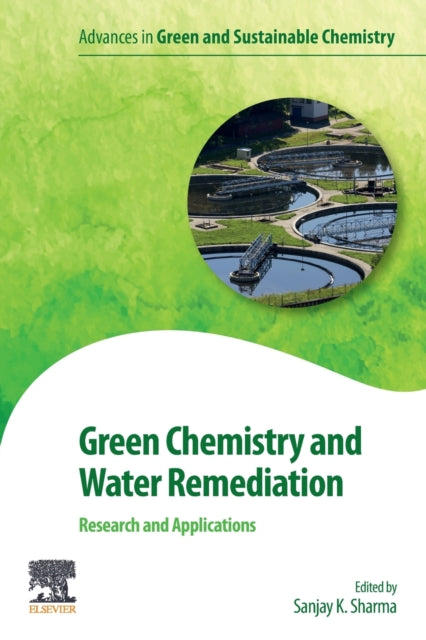Shulph Ink
Green Chemistry and Water Remediation: Research and Applications
Green Chemistry and Water Remediation: Research and Applications
YOU SAVE £9.69
- Condition: Brand new
- UK Delivery times: Usually arrives within 2 - 3 working days
- UK Shipping: Fee starts at £2.39. Subject to product weight & dimension
Bulk ordering. Want 15 or more copies? Get a personalised quote and bigger discounts. Learn more about bulk orders.
Couldn't load pickup availability
- More about Green Chemistry and Water Remediation: Research and Applications
Green Chemistry and Water Remediation explores how integrating green chemistry principles can improve remediation research and practice, ensuring sustainable solutions for chemical pollution in water. It highlights the importance of identifying key areas and encourages the use of green remediation approaches to make informed decisions.
Format: Paperback / softback
Length: 360 pages
Publication date: 23 October 2020
Publisher: Elsevier Science Publishing Co Inc
Green Chemistry and Water Remediation: Research and Applications delves into the profound implications of integrating the principles of green chemistry into remediation research and practice. This comprehensive volume examines both prevalent sources of chemical pollution and the potential of employing green chemistry as a foundation for developing novel or enhanced remediation techniques. By outlining the primary categories of chemical pollutants in water and sustainable approaches to address them, the authors aim to guide chemists in identifying critical areas and fostering the integration of green chemistry into the design of new processes and products. Furthermore, the book underscores and promotes the utilization of the expanding array of green remediation approaches available to experts, empowering researchers, planners, and managers to make informed choices in selecting remediation techniques.
The integration of green chemistry principles into remediation research and practice offers a multifaceted approach to environmental sustainability. By emphasizing the use of renewable resources, waste minimization, and the design of safer and more efficient processes, green chemistry aims to minimize the negative impacts of chemical pollution on ecosystems and human health.
One of the key benefits of integrating green chemistry into remediation is the reduction of chemical usage and the associated environmental impacts. Traditional remediation techniques often rely on the use of toxic and persistent chemicals, which can have long-term adverse effects on soil, water, and wildlife. By employing green chemistry approaches, such as bioremediation, phytoremediation, and chemical oxidation, it is possible to reduce the amount of chemicals required for remediation and minimize the potential for chemical runoff into surrounding environments.
Another advantage of green chemistry is the ability to enhance the effectiveness of remediation processes. By designing remediation techniques that are more targeted and efficient, it is possible to reduce the time and cost of remediation while maximizing the removal of pollutants. For example, phytoremediation, which involves the use of plants to remove pollutants from water, can be more effective than traditional chemical treatments and requires less maintenance and monitoring.
Furthermore, green chemistry can promote the development of sustainable remediation technologies. By incorporating renewable energy sources, such as solar or wind power, into remediation processes, it is possible to reduce the carbon footprint of remediation and promote the use of clean and renewable energy sources.
In addition to its benefits in remediation, green chemistry can also have broader societal implications. By promoting the development of sustainable and environmentally friendly products and processes, green chemistry can help to reduce greenhouse gas emissions, conserve natural resources, and promote economic growth.
However, integrating green chemistry into remediation research and practice also presents challenges. One of the main challenges is the lack of standardized protocols and guidelines for green remediation. Without clear standards and guidelines, it can be difficult for researchers and practitioners to ensure that their remediation techniques are effective, efficient, and sustainable.
Another challenge is the need for interdisciplinary collaboration and knowledge exchange. Remediation is a complex problem that requires expertise from various fields, such as chemistry, biology, environmental science, and engineering. By bringing together experts from different disciplines, it is possible to develop more comprehensive and effective remediation solutions.
To address these challenges, it is important to invest in research and development to improve the understanding of green chemistry and its applications in remediation. This can include funding research projects that explore the use of new and innovative remediation techniques, developing standardized protocols and guidelines for green remediation, and promoting interdisciplinary collaboration and knowledge exchange.
In conclusion, green chemistry and water remediation: research and applications offer a promising approach to addressing the challenges of chemical pollution and promoting environmental sustainability. By integrating the principles of green chemistry into remediation research and practice, it is possible to reduce chemical usage, enhance the effectiveness of remediation processes, promote the development of sustainable remediation technologies, and have broader societal implications. However, challenges such as the lack of standardized protocols and guidelines and the need for interdisciplinary collaboration require attention and investment to overcome. By working together, researchers, practitioners, and policymakers can develop more effective and sustainable solutions to address the growing threat of chemical pollution and protect our environment for future generations.
Weight: 570g
Dimension: 152 x 229 x 26 (mm)
ISBN-13: 9780128177426
This item can be found in:
UK and International shipping information
UK and International shipping information
UK Delivery and returns information:
- Delivery within 2 - 3 days when ordering in the UK.
- Shipping fee for UK customers from £2.39. Fully tracked shipping service available.
- Returns policy: Return within 30 days of receipt for full refund.
International deliveries:
Shulph Ink now ships to Australia, Belgium, Canada, France, Germany, Ireland, Italy, India, Luxembourg Saudi Arabia, Singapore, Spain, Netherlands, New Zealand, United Arab Emirates, United States of America.
- Delivery times: within 5 - 10 days for international orders.
- Shipping fee: charges vary for overseas orders. Only tracked services are available for most international orders. Some countries have untracked shipping options.
- Customs charges: If ordering to addresses outside the United Kingdom, you may or may not incur additional customs and duties fees during local delivery.


